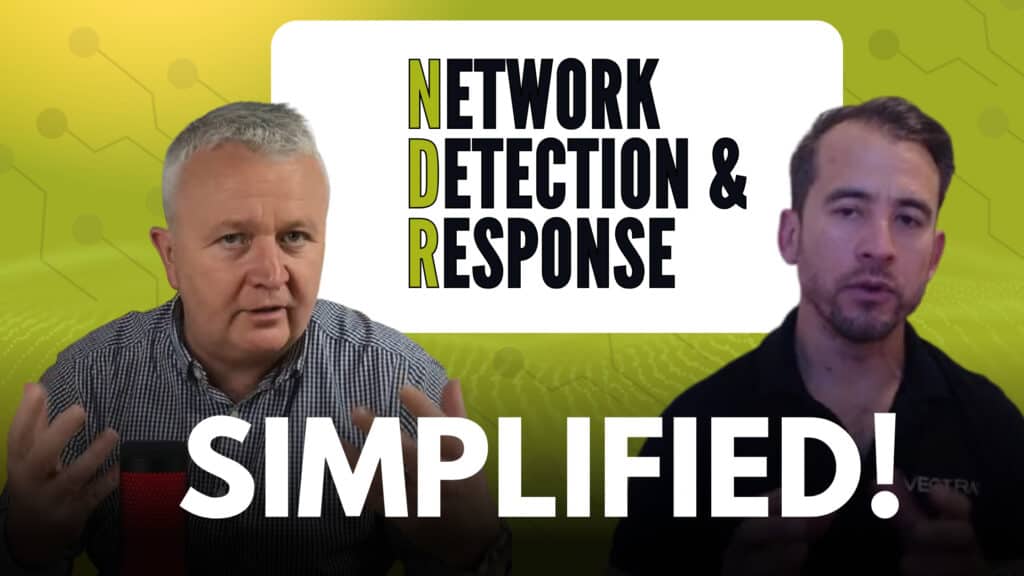Network Detect and Response: Bridging the Gap in Modern Cyber Security
Pulled together from our recent ThreatCast episode exploring the dynamic world of network detection and response technologies, this conversation features insightful discussions on the capabilities of these tools, their ease of maintenance, integration with next-generation Security Operations Centres (SOC), and some of the most notable detections in recent times.
Host: Colin Reid (Commercial Director at Threatscape)
Guest: Dan Crossley (Director, Security Engineering, UKI at Vectra AI)
Setting the Context for NDR Evolution
In this enlightening episode, Colin Reid and Dan Crossley delve into the evolution of network detection and response (NDR) tools. Their conversation spans decades of cyber security advancements—from the early days of intrusion prevention systems (IPS) to the modern era where artificial intelligence and machine learning refine threat detection. The discussion is rooted in real-world experience and practical insights, making it a must-listen for anyone keen to understand how these technologies can fortify an organisation’s security posture.
From Signature-Based IPS to AI-Powered ND
Colin opens by recalling how early IPS technology, once a staple of cyber defence, relied heavily on signature-based detection. As networks grew more complex and threats more elusive, a significant gap emerged—one that modern NDR solutions now aim to bridge. Dan provides a historical perspective, recounting his extensive career in security engineering and the evolution of threat detection. He explains that NDR represents a shift from conventional, signature-driven systems to an approach that leverages AI and machine learning to monitor vast volumes of network traffic. This transformation is critical in an era where unmanaged devices and sophisticated attack vectors challenge traditional defences.
Overcoming Implementation Challenges and Enhancing Detection
The conversation reaches its peak as Colin and Dan dissect the advantages and hurdles inherent in deploying NDR technologies. Key insights include:
Breaking Through Legacy Limitations: Dan explains how legacy systems like IPS, effective in their time, often fall short today because they only scrutinise traffic passing through a firewall. In contrast, NDR solutions operate without relying on predefined signatures, applying advanced analytics to detect subtle anomalies across an entire network.
Tackling Integration and Traffic Capture: A major discussion point centres on the challenges of integrating NDR tools within existing infrastructures. Dan emphasises that the success of an NDR system hinges on its ability to capture the right network traffic—a task complicated by sprawling, legacy environments and restricted control over network segments. He illustrates this with vivid examples, highlighting scenarios where IPS alerts were overwhelmed by data, reducing their effectiveness.
Maximising SIEM Synergy: Both Dan and Colin stress the importance of feeding distilled, actionable data into a Security Information and Event Management (SIEM) system. While vendors often promise a unified view of threat activity, the reality may involve managing multiple data sources. Dan underlines that the true value of NDR lies in its ability to provide high-fidelity signals that empower security teams to respond quickly and accurately to threats.
Real-World Success Stories: The discussion is punctuated by examples of early-stage detections—such as identifying unusual command-and-control communications that preempted ransomware attacks—demonstrating how swift action can safeguard organisations from potentially catastrophic outcomes.
Bridging the Gap: Recommendations and Future Trends
As the podcast draws to a close, Colin and Dan reflect on actionable insights and emerging trends in network detection and response. The key points include:
Identifying and Addressing Security Gaps: Organisations must critically assess their current security posture to pinpoint where traditional IPS systems fall short. NDR tools provide a vital additional layer of detection, particularly in environments with unmanaged or legacy devices.
Investing in Strategic Deployment: Effective NDR implementation hinges on a deep understanding of network topology coupled with the right technology choices. Close collaboration with technical partners and meticulous planning during deployment are essential to capture the necessary network traffic.
Embracing the Future with Innovation: With continual advancements in AI and machine learning, the future of NDR promises enhanced accuracy and efficiency. As networks evolve, these technologies will become even more sophisticated, offering unprecedented levels of threat detection.
Organisations looking to bolster their cyber defences should evaluate their network visibility and consider integrating NDR solutions. Engage with security partners, invest in thorough testing, and remain proactive in adapting to emerging threat









